Bangor's role in D-Day's Normandy landings
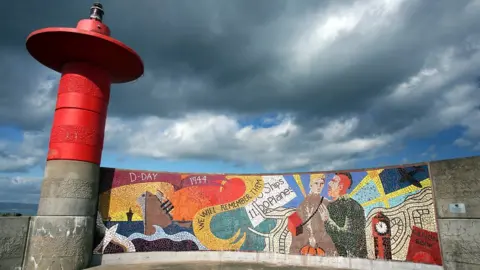 Ards and North Down Borough Council
Ards and North Down Borough CouncilFrom a beach training ground to the inspection of 30,000 American military personnel, the seaside town of Bangor, in County Down, played a crucial role in the D-Day landings.
A colourful mosaic on Eisenhower Pier depicts the significance of the North Down area in the invasion.
On 6 June 1944, British, US and Canadian forces invaded the coast of Normandy in northern France.
The landings were the first stage of Operation Overlord - the invasion of Nazi-occupied Europe - and aimed to bring an end to World War Two.
But before they made it to France, many vessels gathered in Belfast Lough, bringing military visitors to Bangor.
The borough underwent a transformation to accommodate its visitors.
On the rooftop of the now derelict Royal Hotel, a signal station was erected: The top floors of the hotel were used by the Royal Navy before it was joined by the US Navy in 1942.
The Pickie Hotel became the American Red Cross Club, where service men and women could enjoy leisure facilities, deposit money and send telegrams home.
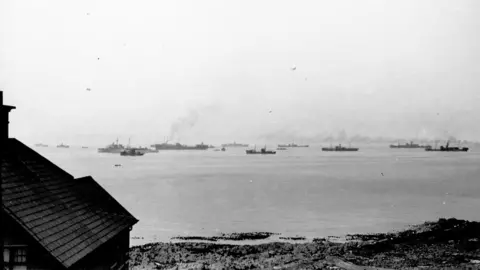 North Down Museum/Mr Gaw
North Down Museum/Mr GawBangor's Main Street was home to two air raid shelters, constructed in the middle of the road, while a number of houses in the area still have bunkers in their back gardens.
Walkers Irish Linen, on Main Street, became a favourite souvenir shop for GIs wishing to send a piece of Northern Ireland back to the States, while Lightbody's fish and chip shop was transformed into a canteen.
Locals were entertained by an American band who often paraded through the town.
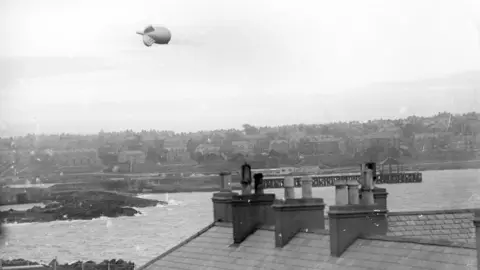 North Down Museum/Mr Gaw
North Down Museum/Mr GawThe first American troopship anchored off Bangor in January 1942 and it is estimated that over 300,000 GIs passed through Northern Ireland on their way to the front line.
Three huge US Navy battleships - the Nevada, Texas and Arkansas - arrived in Belfast Lough in April 1944 and, with D-Day preparations gathering pace, the fleet grew as more ships arrived, ready to deploy.
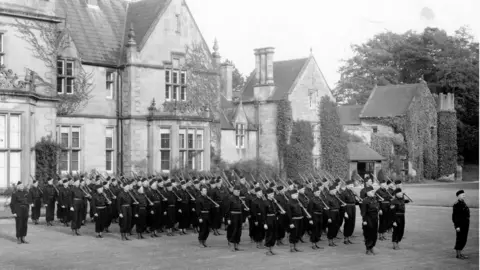 Mr R Clements Lyttle
Mr R Clements Lyttle Before departing for Normandy, Gen Dwight D Eisenhower, commander of the Allied Expeditionary Forces for Operation Overlord, inspected the 30,000 American military personnel.
Gen Eisenhower, who later became US president, set out from the pier in Bangor to visit the cruiser USS Quincy, where he wished the soldiers good luck.
He visited several other ships among the fleet before giving his main speech from the deck of the Texas.
An exhibition at North Down Museum, at Bangor Castle, explains how Gen Eisenhower then went to Ballyholme Bay, from where he watched the US Navy perform exercises.
 Mr R Clements Lyttle
Mr R Clements LyttleBefore they bid farewell to Bangor and the ships were "sealed" for battle on 31 May, the local dance halls were packed as men and women enjoyed one last waltz on Northern Ireland's very own Gold Coast.
On 3 June 1944, the ships left Belfast Lough for Utah and Omaha beaches in Normandy.
Actor Clark Gable, often referred to as "the King of Hollywood", stayed in Northern Ireland to film the departure. The footage he shot has been added to the catalogue of archive material about the Allied invasion.
In remembrance, a replica statue of the Lone Sailor, which was designed for the US Navy Memorial in Washington, resides in North Down Museum.
The memorial is designed to represent all those who served.
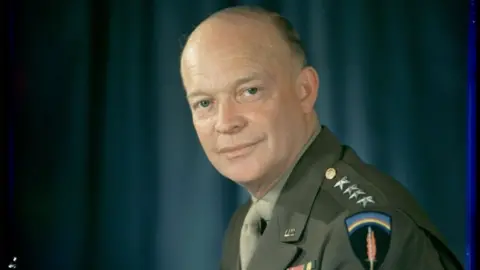 Getty Images
Getty ImagesTo mark the 60th anniversary of the D-Day landings in 2004, Bangor's North Pier was renamed in Eisenhower's honour, during a ceremony attended by his granddaughter Mary-Jean Eisenhower.
A sign on the pier carries an Eisenhower quote reading: "From here started the long hard march to allied victory. Opposite this point was the gathering area for a massive convoy of mixed ships which sailed to arrive at the beaches of Normandy on D-Day, 6 June 1944."
On Saturday, a commemoration of the 75th anniversary of the D-Day landings will be held at Eisenhower Pier.
It will be attended by Elizabeth Kennedy Trudeau, the US Consul General in Belfast.